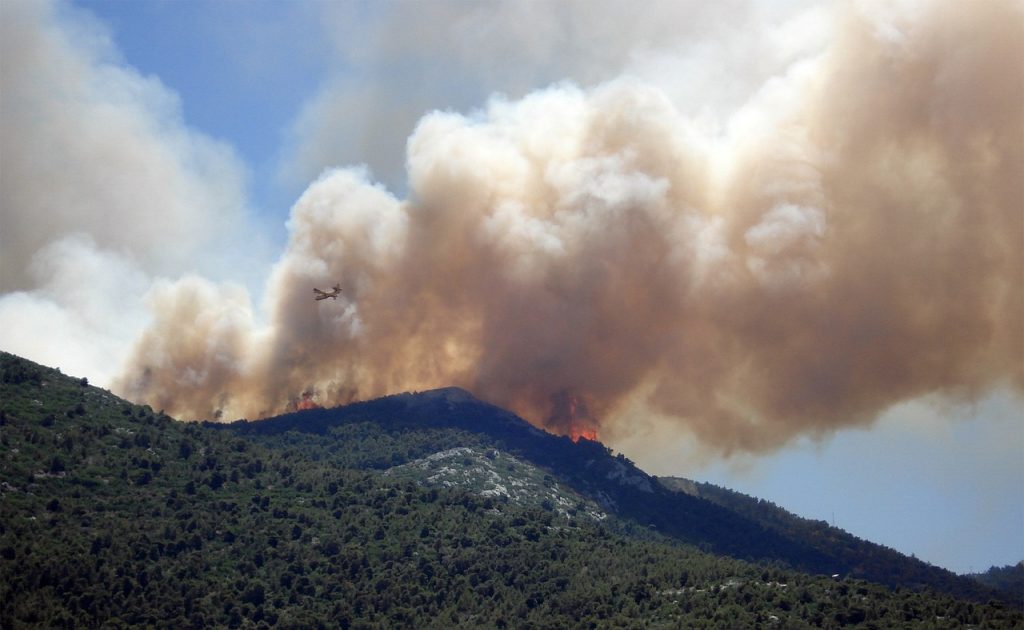Many residents are alarmed by the visible wildfire smoke which has been wafting down from Eastern Canada this summer. Unfortunately, experts from the National Oceanic and Atmospheric Administration (NOAA) report events like this will become more common with rainfall and temperatures fluctuating and reaching extreme levels as climate change persists. Therefore, it is important for Berks County residents to understand what the smoke means for our community going forward and ways we can protect ourselves against potential health hazards.
What is wildfire smoke?
According to the U.S. Environmental Protection agency (EPA), wildfire smoke is commonly comprised of water vapor, hazardous gas and chemical air pollutants, and particle pollution. But what is particle pollution? When any material such as wood or charcoal is burnt it is broken down into small fragments also known as particles or particulate matter (think back to science class – no matter is created or destroyed in a chemical reaction). In fact, a single particle is so small that it is unperceivable to the human eye and stays suspended in air. Due to the extremely high, and therefore hazardous, concentration of particles produced by the wildfires, these particles became visible in Berks County as orange and gray hazes.
Does wildfire smoke affect my health?
Health effects and severity depend on a number of factors, including particulate matter size, pre-existing conditions, and social circumstances. Larger smoke particles the size of dust, pollen, or mold are often respiratory and eye irritants while smaller smoke particles can enter the bloodstream. The Centers for Disease Control Prevention (CDC) state immediate effects of wildfire smoke exposure include:
- Coughing
- Trouble Breathing
- Wheezing
- Asthma Attacks
- Stinging Eyes
- Scratchy Throat
- Runny Nose
- Irritated sinuses
- Headaches
- Tiredness
- Chest Pain
- Fast Heartbeat
Serious reactions to smoke exposure can include Bronchitis, reduced lung function, heart failure, heart attack, and stroke. In their Code Red Alert earlier this summer, the PA Department on Environmental Protection advised that all residents should limit outdoor activities while children, older people, individuals who work outdoors, and individuals with lung or respiratory conditions such as asthma, emphysema, or bronchitis should avoid prolonged or heavy outdoor exertion.
How can I protect myself?
Both the EPA and CDC report that the elimination or reduction of outdoor activities is the best way to avoid the health risks of wildfire smoke. Other methods of protection against severe wildfire smoke include wearing respirators and using air cleaners or filters. The CDC stresses that only particulate respirators such as NIOSH, N95, or P100 are protective against wildfire smoke. These respirators can be purchased at local pharmacies or online. Since respirators are not sized for children, the most effective protection for children is to stay indoors. During periods of poor air quality, individuals can regulate particulate matter levels indoors by using air conditioners, avoiding vacuuming, and limiting the use of candles, gas, wood-burning stoves, fireplaces, tobacco products, or aerosol sprays.
How can wildfires be prevented? How can I help?
A 2021 study supported by NOAA found that the main driver of an increase in fire weather was climate change. This risk can be seen by increased heat, extended drought, and a thirsty atmosphere. The Canadian wildfire season, which takes place from May through October, usually experiences an annual loss of 6 million acres. This season, however, the country has already lost around 10 million acres. Consequently, local meteorologists say this may not be the last time Pennsylvania encounters severe wildfire smoke.
You can create a greener and healthier community today by becoming involved in local government or volunteering with one of the county’s environmental organizations. In Reading, an Environmental Advisory Council helps the City Council analyze environmental and sustainability issues to protect the health, safety, and welfare of Berks County residents. Neighbors and business owners can take pride in their communities by joining the City’s adopt-a-block and adopt-a-tree programs. These programs make sure trash does not end up in our waterways and drinking water (yikes!) and help trees offer shade and clean air to everyone. Berks County is on the right track to protect its people, the planet, and our collective prosperity, but we need to push ourselves and our leaders to pick up the pace if we want to stop the smoke from settling.
Jasmine Slusser is an intern and Sustainability Communication Specialist for the City of Reading Environmental Advisory Council. She is pursuing a Masters Degree in Public Health – Environmental Health Science and Policy at The George Washington University in Washington, DC.




